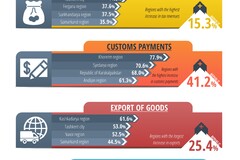Analysis of business activity in the context of the regions of the Republic of Uzbekistan is monthly calculated by CERR on the basis of operational data (monitoring in all regions of the Republic, according to the data of the State Customs Committee, State Tax Committee, Central Bank and UzEX).
The monitoring results showed that the volume of tax revenues of the Republic in the period from January 1 to June 27 this year increased by 15.3% compared to the same period last year.
At the same time, a significant increase in tax revenues was recorded in Ferghana (+37.6%), Surkhandarya (+37.5%), Samarkand (+35.9%), Bukhara (+35.9%), Khorezm (+35.2%), Andijan (+33.6%) regions and Tashkent (+44.6%).
The growth of tax revenues was ensured due to positive changes in the economy, improvement of the tax administration system, including the introduction of new administrative tools, digitalization and automation of processes, legalization of entrepreneurial activity and simplification of the procedure for compliance with tax legislation.
Revenues from custom duty payments for the analyzed period increased by 41.2% compared to the same period 2021. The largest increase in customs receipts was observed in Khorezm (+77.9%), Syrdarya (+70.6%), and Andijan (+61.3%), Bukhara (+56.3%), Jizzakh (+49.8%) regions and in the Republic of Karakalpakstan (+68.0%).
The increase in customs revenues is associated with the growth of foreign trade turnover, measures taken by customs authorities to simplify customs procedures, accelerate the release of goods into free circulation and the introduction of new methods of customs administration.
According to the State Customs Committee, the volume of exports of goods from the beginning of this year to June 27 increased by 25.4% compared to the same period last year. A significant increase in the volume of exports of goods was noted in Kashkadarya (+61.6%), Navoi (+52.5%), Samarkand (+44.5%), Andijan (+33.5%), Namangan (+26.9%) regions and Tashkent city (+53.0%).
The increase in Uzbekistan's exports is explained by the growing growth rates of exports of industrial goods, food products, chemicals substances and agri-food products.
At the same time, the decrease in exports of goods was observed in Bukhara (-22.2%), Surkhandarya (-6.8%) regions and in the Republic of Karakalpakstan (-17.0%).
The reduction in the volume of exports in the Bukhara region is caused by the fact that in January-June 2022, exports of cotton fiber decreased in the region, which is due to the direction of these products to the domestic market.
The decrease in exports in the Republic of Karakalpakstan is explained by a reduction in exports of plastics and products made from them and yarn, pharmaceutical products and the complete cancellation of exports of cotton fiber with the redirection of these products to the domestic market.
In turn, the decrease in exports to Surkhandarya region is associated with a reduction in exports of fruit and vegetable products and the redirection of cotton fiber and yarn to the domestic market.
The volume of transactions on the UzEx for the analyzed period increased by 42.8%. A significant increase in exchange activity is observed in Khorezm (+68.1%), Navoi (+65.4%), Jizzakh (+54.6%) regions, in the Republic of Karakalpakstan (+49.8%) and in Tashkent city (+68.5%).
The growth in the volume of transactions in these regions is ensured by increasing the sale of such goods as technical seeds, mineral fertilizers, sugar, vegetable oil, ethyl alcohol, automobile gasoline, diesel fuel, construction and household materials, rolled ferrous metals, etc.
At the same time, a decrease of 7.2% was observed in the Syrdarya region, which is explained by a decrease in the number and volume of transactions for trade in polypropylene, cotton fiber, technical seeds, vegetable oil, meal and husk, ferrous metal, cement, wheat, soap product and livestock feed.
Yusup Jumabaev, CERR






















leave a comment